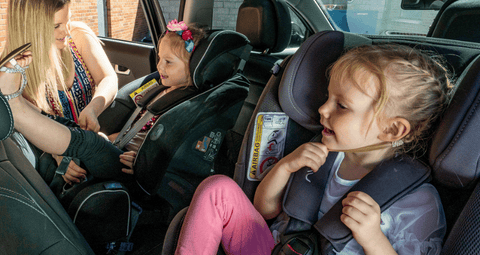Many of our customers are new to the idea of rear-facing car seats, however, the concept has been around since 1988.
We have always recommended rear-facing seats because they are that much safer than forward-facing car seats. As a result, it is now a legal requirement for children under the age of 15 months to travel rear-facing.
Beyond 15 months, it’s still the best option in most cases. Some rear-facing seats are suitable for children up to 18kgs. Some will span right up to 25kg.
Why is rearward facing safer?
The most dangerous car accidents are frontal collisions. They represent the accidents where the highest speeds and the greatest forces are at play. When a child is forward-facing and a frontal collision occurs the child is flung forward in the seat, being caught by the harness. This puts stress on the neck, the spine, and the internal organs.
To put that into context, a baby’s head makes up 25% of its body weight compared to an adult whose head weights 6% of their total body weight.
Rearward facing seats counteract this forward movement – the child would be thrown back into the car seat. This distributes the force more evenly across their backs and causes far less stress on ‘bendy’ parts of the body.
While most parents want to use rear-facing seats, some still don’t believe they can or should. Below are some typical questions we receive:
I can’t fit a rearward-facing car seat in my car because I don’t think I have enough room?
Usually, this isn’t an issue. Some of the more compact rearward facing seats take up no more room than an infant carrier on a base. Come visit us in-store and will try to find the perfect seat for your child and car.
Where do the child’s legs go when rearward facing?
The majority of extended rearward facing car seats are installed with a gap between the base of the seat and the backrest of the vehicle seat. How big that gap depends on the space between the car’s back and front seats but even when there is not enough space for a large gap, most children are happy to sit with their legs crossed or bent.
What do they do with their legs when rear-facing?
Children are very flexible, bones do not start to calcify till around 3 years, also the joints are more mobile, as their heads are larger in proportion than ours they tend to be top-heavy therefore when sitting they would normally sit with their legs tucked up or cross-legged. When sitting in a car seat whether forward or rear-facing they will often cross their legs as sitting with legs hanging is uncomfortable as they are not supported. When rear-facing their legs are supported by the back of the vehicle seat and they are happy to sit with their legs crossed or frogged.
How do I communicate with my child in the car?
Strictly speaking, we can’t advocate communicating with your child while you are driving (regardless of whether they are rearward or forward-facing). However, we do sell specially designed mirrors that allow a child to see you and would allow you to see them in your rear-view mirror.
Won’t my child get bored being rearward facing?
In our experience, the opposite is true! In a forward-facing car seat, all children can see is the back of the front seat with a limited view of the side window. In a rear-facing car seat, the child has a great view out of the side and rear windows.
How does a rear-facing seat work if you get rear-ended?
Rear-end crashes account for only 5% of the total amount of car accidents and usually occur at much slower speeds than frontal ones. In a rear-end collision, both vehicles are moving in the same direction which throws the car that is hit from behind, forward. This means that the force of the crash are far lower than they are in a frontal impact where the vehicle comes to a sudden halt.
Overall, they’re effective in rear-ending collisions, meanwhile, the hazards in such situations pose less threat than frontal collisions, and so your overall safety protection is significantly higher.
What are rearward facing tether straps?
The tether straps attach to the seat in front. Either fitted to the front seat runners, designated tether loops (Scandinavian cars) or around the front seat pillars. They reduce the rebound (backward movement of the car seat after a frontal collision).
How long should a child be in a rear-facing car seat?
Tests prove that rear-facing car seats are far safer than forward-facing car seats. Therefore, we always advise our customers to use rear-facing seats for as long as possible.
However, if you want to move to forward-facing seats, R44 seats use a weight-based system and are approved for use from 9kgs. Forward-facing R129 or i-Size seats use a height-based system and can be used from 76cms.
Do not hesitate to get in touch with a member of our team if you have any more questions.
Book a consultation with one of our expert car seat specialists today.







Comments (0)
There are no comments for this article. Be the first one to leave a message!